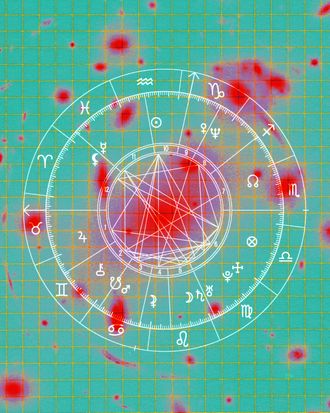
If you’ve been asked “what time were you born?” and didn’t understand why, this is for you. An astrological birth chart — also referred to as the “natal chart” — uses the exact date, time, and location of your birth to re-create a snapshot of the sky at your precise moment of arrival. Within the folds of this circular map, you’ll find all the planets and celestial objects tracked in astrology, along with the zodiac signs they were occupying. Already confused? Well, it’s a lot! But fear not, my friend. Read on to explore the fundamentals of the birth chart.
First, where do I even find my birth chart?
Back in the day, the only way to calculate a birth chart was by hand, using a protractor and a table known as an “ephemeris.” Thankfully, we have astrology software now, making it possible to calculate a complete birth chart in less than a second. To that end, TimePassages is my favorite app (available on both iOS and Android) for rendering birth charts, along with the website astro.com.
To pull up a birth chart (whether it be yours or someone else’s), you’ll need the date, time, and location of birth. But keep in mind that the birth chart is an extremely sensitive diagram that requires accurate data. In fact, the birth chart shifts radically every four minutes (more on that later), which is why it’s critical to have a precise time of birth — approximates or estimates can (and will) skew the results. So, when in doubt, it’s best to verify the information with a birth certificate, baby book, or parent before calculating.
Okay, I have my birth chart. Now what?
Seeing your birth chart for the first time is … overwhelming. Filled with unfamiliar symbols, strange numbers, and a whole complicated assortment of shapes and lines, making sense of a birth chart can feel like deciphering ancient hieroglyphics. And, in a way, it sort of is: Astrology is a complex visual language that’s been around for thousands of years. Accordingly, it requires practice (and patience) to understand this intricate symbolic diagram.
Start with the ascendant (also known as the rising sign). Quite literally, the ascendant refers to the zodiac sign ascending over the eastern horizon at your exact moment of birth. Though the visual location of the ascendant will vary based on astrology software, it’s usually located on or around the nine o’clock position, and is often symbolized by a circle with a horizontal line in the middle.
The ascendant represents your perception of reality, along with the recurring patterns, themes, and cycles you encounter throughout your life. This placement establishes the architecture for your entire birth chart — when reading a birth chart, we begin at that exact point and move counterclockwise around the circle.
What are the sections of a birth chart?
As your eyes move across the diagram, you may notice that the chart is divided into different sections — 12, to be exact. These pie slices are referred to as “houses.” Avoid the common misstep of conflating houses with zodiac signs (yes, there are 12, but it’s not the same thing). The houses are a visual expression of Earth’s 24-hour rotation around its axis, which means that each House represents approximately two hours of time.
What’s more, each house represents a different area of your life. As you move across the wheel, from left to right, the houses transition from more personal and tangible to interpersonal and abstract. Below are a few keywords for each house to help you familiarize yourself with the regions of the birth chart.
- 1st House: Self, identity, physical appearance
- 2nd House: Material possessions, money, values
- 3rd House: Peers, communication, siblings
- 4th House: Home, family, origins
- 5th House: Creativity, romance, children
- 6th House: Health, wellness, routines
- 7th House: Partnership, contracts, marriage
- 8th House: Inheritances, sex, transformation
- 9th House: Philosophy, travel, higher education
- 10th House: Career, legacy, reputation
- 11th House: Activism, technology, humanitarianism
- 12th House: Intuition, secrets, spirituality
Some houses in your birth chart will have “things” inside of them (in just a moment, we’ll identify those “things” as planets), and other houses will not. If you don’t have a planet in a house, it does not mean that the keywords of that house won’t appear in your life. In fact, every house plays a vital role in our birth chart regardless of whether a planet occupies that domain. So, if your fifth house of creativity or seventh house of partnership is “empty,” please don’t panic. It’s totally normal!
Okay, what are all these symbols, and what do they mean?
Now that you’ve familiarized yourself with the landscape of the birth chart, the next step is learning about the symbols. Every planet and celestial body measured in astrology has a symbol (also referred to as a “glyph”), along with each of the 12 zodiac signs. Taking that a step further, every planet occupies a zodiac sign, so — in a birth chart — different symbols are often stacked next to each other.
Let’s break this down just a wee bit further:
The Planets
Every planet and celestial object with astrological relevance has a glyph. In your birth chart, the position of these planets (in other words, which house the planets occupy) reveals how (and where) their energy appears in your life. Below are keywords associated with each planet, along with how to identify their symbol.
- The Sun (circle with dot in middle): Identity, purpose, ego
- The Moon (crescent moon): Emotions, innerworld, security
- Mercury (circle with two “horns” and cross underneath): Communication, expression, the mind
- Venus (circle with cross underneath): Values, taste, sensuality
- Mars (circle with arrow pointing diagonally): Motivation, action, sexuality
- Jupiter (curvy number “4”): Expansion, abundance, luck
- Saturn (curvy letter lowercase “h”): Responsibilities, lessons, maturity
- Uranus (curvy letter uppercase “H” with circle underneath): Innovation, rebellion, eccentricity
- Neptune (trident): Spirituality, dreams, illusions
- Pluto (circle framed by two arms and cross underneath): Transformation, metamorphosis, rebirth
The Signs
Now that you know what the planets do, the next important piece of information is which zodiac sign they occupy. To put it simply, the zodiac sign shows how the planet executes its mission. For instance, if Venus is about values and love, Venus in the airy zodiac sign of Gemini will express itself through curiosity, communication, and play. Alternatively, if Venus is in mysterious Scorpio, it will value intensity, power, and depth. Locate keywords for each sign below, along with its symbol.
- Aries (letter “V” with curved top): Bravery, passion, spontaneity
- Taurus (circle with two horns): Loyalty, commitment, practicality
- Gemini (roman numeral “two”): Curiosity, communication, play
- Cancer (horizontal “69”): Sensitivity, protection, creativity
- Leo (circle with curly tail): Performance, courage, pride
- Virgo (letter “M” with curly tail): Organization, structure, pragmatism
- Libra (half circle with arms and line underneath): Balance, harmony, justice
- Scorpio (letter “M” with pointed tail): Intensity, power, depth
- Sagittarius (arrow pointing diagonally): Adventure, exploration, discovery
- Capricorn (curvy letter “G”): Ambition, responsibility, success
- Aquarius (two zig-zag lines): Innovation, rebellion, activism
- Pisces (curvy letter “H”): Imagination, psychic powers, mysticism
How do I put it all together?
With a basic understanding of houses, planets, and zodiac signs, you’ll be able to start analyzing the birth chart. Once you get the hang of it, the formula for interpretation is pretty simple: Planet + Sign + House. In other words, what is a planet doing, how is it doing it, and what area of life is it showing up in? For example, Mars in Virgo in the third house will be motivated (Mars) through structure (Virgo) through its interpersonal relationships (third house), while the moon in Sagittarius in the 12th house will process its emotions (the Moon) through discovering (Sagittarius) its psychic abilities (12th house).
My advice? Take your time! Your ability to create strong astrological interpretations will be strengthened the more you practice, so don’t be afraid to experiment with narratives and bold observations! Virtual communities like the Constellation Club, run by moi, are great resources as well, since it’s helpful to get feedback on your interpretations (especially when you’re just starting out).
But, perhaps most importantly, remember to go at your own pace. One of the mystical axioms I say often is “you will know what you need to know when you need to know it.” And that, of course, includes all things astrology. You will understand as soon as you are meant to … and not a second too late. Trust the process.
More From This Series
- Get Ready for the Solar Eclipse in Aries to Change You
- How to Understand Every Zodiac Sign, by Element
- A Guide to the Air Signs: Gemini, Libra, and Aquarius





